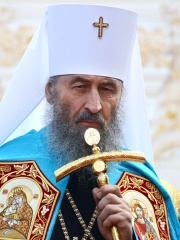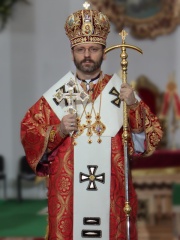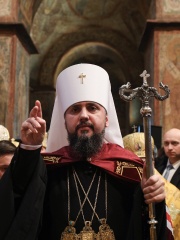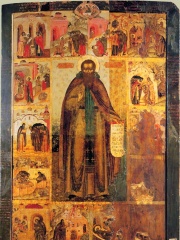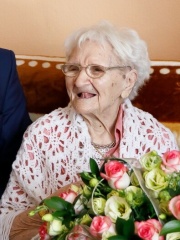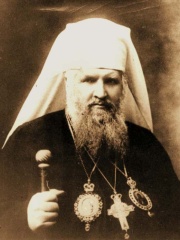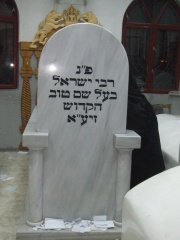
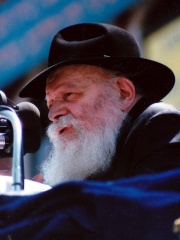
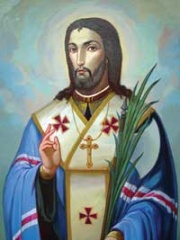
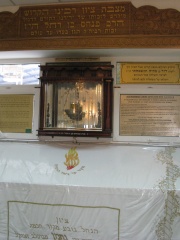
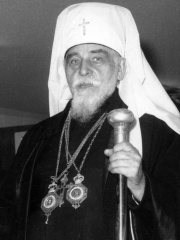
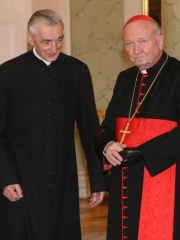
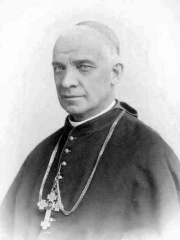
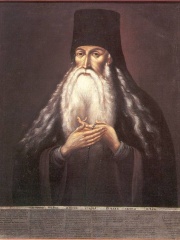
The Most Famous
RELIGIOUS FIGURES from Ukraine
This page contains a list of the greatest Ukrainian Religious Figures. The pantheon dataset contains 3,187 Religious Figures, 25 of which were born in Ukraine. This makes Ukraine the birth place of the 21st most number of Religious Figures behind China, and Syria.
Top 10
The following people are considered by Pantheon to be the top 10 most legendary Ukrainian Religious Figures of all time. This list of famous Ukrainian Religious Figures is sorted by HPI (Historical Popularity Index), a metric that aggregates information on a biography's online popularity. Visit the rankings page to view the entire list of Ukrainian Religious Figures.

1. Baal Shem Tov (1700 - 1760)
With an HPI of 71.50, Baal Shem Tov is the most famous Ukrainian Religious Figure. His biography has been translated into 41 different languages on wikipedia.
Israel ben Eliezer (c. 1700 –1760), known as the Baal Shem Tov (; Hebrew: בעל שם טוב) or BeShT (בעש״ט), was a Jewish mystic and healer regarded as the founder of Hasidic Judaism. A baal shem tov is a "Master of the Good Name"—that is, one able to work miracles using a secret name of God. Other sources explain his sobriquet as arising from a reputation of being a saintly, or superior, Baal Shem ('miracle-worker'); hence, he was given the nickname Baal Shem Tov (the "good Baal Shem"). Biographical information about the Baal Shem Tov comes from contemporary documents from the Polish–Lithuanian Commonwealth and the legends about his life and behavior collected in the Praise of the Besht (שבחי הבעש״ט, Shivḥei haBesht). A central tenet of the teachings associated with the Baal Shem Tov is devekut, a direct connection with the divine, which is infused in every human activity and every waking hour. Prayer is of supreme importance, along with the mystical significance of Hebrew letters and words.

2. Menachem Mendel Schneerson (1902 - 1994)
With an HPI of 69.66, Menachem Mendel Schneerson is the 2nd most famous Ukrainian Religious Figure. His biography has been translated into 29 different languages.
Rabbi Menachem Mendel Schneerson (April 18, 1902 [O.S. April 5, 1902] – June 12, 1994; AM 11 Nissan 5662 – 3 Tammuz 5754), known to adherents of the Chabad-Lubavitch movement as the Lubavitcher Rebbe or simply the Rebbe, was an Orthodox rabbi and the Rebbe of the Lubavitch Hasidic dynasty. He is considered one of the most influential Jewish leaders of the 20th century. As leader of the Chabad-Lubavitch movement, he took an insular Hasidic group that almost came to an end with the Holocaust and transformed it into one of the most influential movements in religious Jewry, with an international network of over 5,000 educational and social centers. The institutions he established include kindergartens, schools, drug-rehabilitation centers, care homes for the disabled, and synagogues. Schneerson's published teachings fill more than 400 volumes, and he is noted for his contributions to Jewish continuity and religious thought, as well as his wide-ranging contributions to traditional Torah scholarship. He is recognized as the pioneer of Jewish outreach. During his lifetime, many of his adherents believed that he was the Messiah. His own attitude to the subject, and whether he openly encouraged this, is hotly debated among academics. During Schneerson's lifetime, the messianic controversy and other issues elicited fierce criticism from many quarters in the Orthodox world, especially earning him the enmity of Elazar Shach. In 1978, the U.S. Congress asked President Jimmy Carter to designate Schneerson's birthday as the national Education Day in the U.S. It has been since commemorated as Education and Sharing Day. In 1994, Schneerson was posthumously awarded the Congressional Gold Medal for his "outstanding and lasting contributions toward improvements in world education, morality, and acts of charity". Schneerson's resting place attracts Jews for prayer.

3. Josaphat Kuntsevych (1580 - 1623)
With an HPI of 69.06, Josaphat Kuntsevych is the 3rd most famous Ukrainian Religious Figure. His biography has been translated into 28 different languages.
Josaphat Kuntsevych, OSBM (c. 1580 – 12 November 1623) was a Basilian hieromonk and archeparch of the Ruthenian Greek Catholic Church who served as Archbishop of Polotsk from 1618 to 1623. On 12 November 1623, he was beaten to death with an axe during an anti-Catholic riot by Eastern Orthodox Belarusians in Vitebsk, in the eastern peripheries of the Polish–Lithuanian Commonwealth. His death reflects the conflict between the Eastern Orthodox Church and the Eastern Catholic Churches that intensified after four Ruthenian Orthodox Church (Kiev Metropolitanate) bishops transferred their allegiance from the Ecumenical Patriarchate in Constantinople to the Holy See, under the terms laid down by the 1439 Council of Florence, by signing the 1596 Union of Brest. Archeparch Josaphat remains one of the best-known victims of anti-Catholic violence for his role in both personally accepting and very effectively spreading the Eastern Catholic Churches as a hieromonk and bishop, and was canonized in 1867 by Pope Pius IX as a saint and a martyr of the Catholic Church. In response to the nickname "The Soul-Snatcher", which Josaphat received from both his Orthodox and Calvinist opponents, his biographer, Fr. Demetrius Wysochansky, has written:"In summing up his pastoral activities which were directed towards the one goal of snatching souls, his contemporaries and witnesses to his life were able to say: 'Whatever Catholics there are in Polotsk, are the fruit of the pastoral labors of Josaphat.' To this statement one may add that whatever Catholics there have been in Lithuania and Byelorussia in the 350 years since Josaphat's death, may all attribute their Catholic Faith to the labors and blood of Josaphat, the 'Soul-Snatcher.'"

4. Nachman of Breslov (1772 - 1810)
With an HPI of 68.47, Nachman of Breslov is the 4th most famous Ukrainian Religious Figure. His biography has been translated into 22 different languages.
Nachman of Breslov (Hebrew: רַבִּי נַחְמָן מִבְּרֶסְלֶב Rabbī Naḥmān mīBreslev), also known as Rabbi Nachman of Breslev, Rabbi Nachman miBreslev, Reb Nachman of Bratslav, Reb Nachman Breslover (Yiddish: רבי נחמן ברעסלאווער Rebe Nakhmen Breslover), and Nachman from Uman (April 4, 1772 – October 16, 1810), was the founder of the Breslov Hasidic movement. He was particularly known for his creative parables, drawing on Eastern European folktales to infuse his teaching with deeply kabbalistic yet universally accessible remedies, pieces of advice, and parabolic stories. He emphasized finding and expressing one’s uniqueness while steering away from despair in a world he saw as becoming more and more uniform. Through Martin Buber's translation, his teaching is thought to have influenced some 20th-century writers, including Franz Kafka. Rabbi Nachman, a great-grandson of the Baal Shem Tov, revived the Hasidic movement by combining the Kabbalah with in-depth Torah scholarship. He attracted thousands of followers during his lifetime, and his influence continues today in Breslover Hasidism and non-Hasidic movements. Rabbi Nachman's religious philosophy revolved around closeness to God, speaking to God in normal conversation "as you would with a best friend", and being happy. The concept of hitbodedut was central to his thinking. Rabbi Nahman was born the 1st of Nisan and his day of passing (Yortzeit/Hilula) is on the 18th of Tishrei.
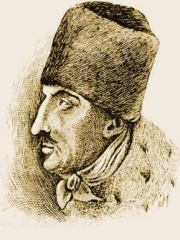
5. Jacob Frank (1726 - 1791)
With an HPI of 66.29, Jacob Frank is the 5th most famous Ukrainian Religious Figure. His biography has been translated into 23 different languages.
Jacob Joseph Frank (Hebrew: יעקב פרנק; Yiddish: יעקבֿ פֿראַנק; Polish: Jakub Józef Frank; born Jakub Lejbowicz; 1726 – 10 December 1791) was a Polish-Jewish religious leader who claimed to be the reincarnation of the self-proclaimed messiah Sabbatai Zevi (1626–1676) and also of the biblical patriarch Jacob. The religious authorities of the Jewish community excommunicated Frank and his followers due to his heretical doctrines that included deification of himself as a part of a trinity and other controversial concepts such as neo-Carpocratian "purification through transgression". Frank’s teachings led his sect into scandalous practices, including ritualized orgies, incestuous acts—most notably between fathers and daughters—and the deliberate violation of Jewish moral laws, which he preached were necessary to hasten a messianic redemption through embracing the "abyss" of sin. Frank arguably created a religious movement, now referred to as Frankism, which incorporated aspects of Christianity and Judaism. His followers, known as Frankists, engaged in sexually promiscuous rites, such as the infamous 1756 incident in Lanskroun where they were allegedly caught dancing around a half-naked woman symbolizing the Shechinah. Later, Frankists were encouraged to convert in mass to Catholicism. The development of Frankism was one of the consequences of the messianic movement of Sabbatai Zevi. This religious mysticism followed socioeconomic changes among the Jews of Poland, Lithuania and Ruthenia.

6. Josyf Slipyj (1892 - 1984)
With an HPI of 65.14, Josyf Slipyj is the 6th most famous Ukrainian Religious Figure. His biography has been translated into 24 different languages.
Josyf Slipyi (Ukrainian: Йосиф Сліпий, born as Ukrainian: Йосиф Коберницький-Дичковський, romanized: Yosyf Kobernyts'kyy-Dychkovs'kyy; 17 February 1892 – 7 September 1984) was a Major Archbishop of the Ukrainian Greek Catholic Church and a cardinal of the Catholic Church.

7. Marian Jaworski (1926 - 2020)
With an HPI of 64.24, Marian Jaworski is the 7th most famous Ukrainian Religious Figure. His biography has been translated into 23 different languages.
Marian Franciszek Jaworski (Ukrainian: Мар'ян Францішек Яворський, 21 August 1926 – 5 September 2020) was a Cardinal Priest and Archbishop of Lviv of the Latins in the Roman Catholic Church. He was a close friend of Pope John Paul II.

8. Jan Puzyna de Kosielsko (1842 - 1911)
With an HPI of 63.49, Jan Puzyna de Kosielsko is the 8th most famous Ukrainian Religious Figure. His biography has been translated into 17 different languages.
Prince Jan Duklan Maurycy Paweł Puzyna de Kosielsko (13 September 1842 – 8 September 1911) was a Polish Catholic Cardinal who was auxiliary bishop of Lwów (now Lviv, Ukraine) from 1886 to 1895, and the bishop of Kraków from 1895 until his death in 1911. Named a Cardinal in 1901, he was known for his conservative views and authoritarianism.

9. Paisius Velichkovsky (1722 - 1794)
With an HPI of 62.95, Paisius Velichkovsky is the 9th most famous Ukrainian Religious Figure. His biography has been translated into 19 different languages.
Paisius Velichkovsky or Wieliczkowski (Paisie de la Neamţ in Romanian; Паисий Величковский in Russian; Паїсій Величковський in Ukrainian; 20 December 1722 – 15 November 1794) was an Eastern Orthodox monk and theologian who helped spread staretsdom or the concept of the spiritual elder to the Slavic world. He is a pivotal figure in Orthodox Church history.
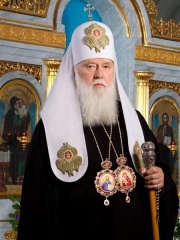
10. Filaret (b. 1929)
With an HPI of 62.93, Filaret is the 10th most famous Ukrainian Religious Figure. His biography has been translated into 25 different languages.
Patriarch Filaret (secular name Mykhailo Antonovych Denysenko, Ukrainian: Михайло Антонович Денисенко, born 23 January 1929) is a Ukrainian religious leader, currently serving as the primate and Patriarch of the Ukrainian Orthodox Church – Kyiv Patriarchate. The Orthodox Church of Ukraine, that he left in 2019, views him as the Honorary Patriarch emeritus, while the Ecumenical Patriarchate of Constantinople recognises him as former Metropolitan of Kyiv. He was formerly the Metropolitan of Kiev and the Exarch of Ukraine in the Patriarchate of Moscow (1966–1992). After joining the Kyiv Patriarchate, he was defrocked and in 1997 excommunicated by the ROC. On 11 October 2018, the Patriarchate of Constantinople reinstated him in church communion. However, while restored to the episcopate, the Ecumenical Patriarchate never recognised him as Patriarch and views him as the former Metropolitan of Kyiv. On 15 December 2018, the Ukrainian Orthodox Church of the Kyiv Patriarchate united with the Ukrainian Autocephalous Orthodox Church and some members of the Ukrainian Orthodox Church (MP) into the Orthodox Church of Ukraine; the Ukrainian Orthodox Church of the Kyiv Patriarchate thus ceased to exist.
People
Pantheon has 25 people classified as Ukrainian religious figures born between 983 and 1980. Of these 25, 5 (20.00%) of them are still alive today. The most famous living Ukrainian religious figures include Filaret, Onufriy, and Mykola Bychok. The most famous deceased Ukrainian religious figures include Baal Shem Tov, Menachem Mendel Schneerson, and Josaphat Kuntsevych. As of April 2024, 1 new Ukrainian religious figures have been added to Pantheon including Mykola Bychok.
Living Ukrainian Religious Figures
Go to all RankingsFilaret
1929 - Present
HPI: 62.93
Onufriy
1944 - Present
HPI: 60.54
Mykola Bychok
1980 - Present
HPI: 58.39
Sviatoslav Shevchuk
1970 - Present
HPI: 56.75
Epiphanius I of Ukraine
1979 - Present
HPI: 51.68
Deceased Ukrainian Religious Figures
Go to all RankingsBaal Shem Tov
1700 - 1760
HPI: 71.50
Menachem Mendel Schneerson
1902 - 1994
HPI: 69.66
Josaphat Kuntsevych
1580 - 1623
HPI: 69.06
Nachman of Breslov
1772 - 1810
HPI: 68.47
Jacob Frank
1726 - 1791
HPI: 66.29
Josyf Slipyj
1892 - 1984
HPI: 65.14
Marian Jaworski
1926 - 2020
HPI: 64.24
Jan Puzyna de Kosielsko
1842 - 1911
HPI: 63.49
Paisius Velichkovsky
1722 - 1794
HPI: 62.95
Theodosius of Kiev
1029 - 1074
HPI: 62.32
Tekla Juniewicz
1906 - 2022
HPI: 62.03
Andrey Sheptytsky
1865 - 1944
HPI: 61.95
Newly Added Ukrainian Religious Figures (2025)
Go to all RankingsOverlapping Lives
Which Religious Figures were alive at the same time? This visualization shows the lifespans of the 15 most globally memorable Religious Figures since 1700.

